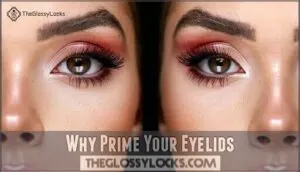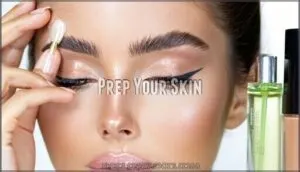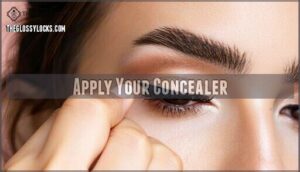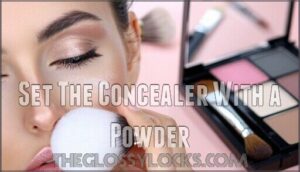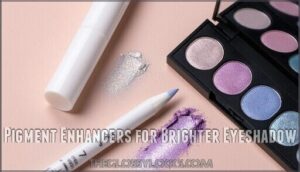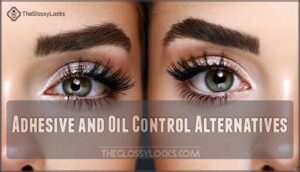This site is supported by our readers. We may earn a commission, at no cost to you, if you purchase through links.
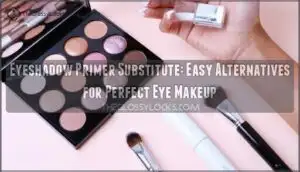
A creamy concealer works beautifully—just dab a thin layer on your eyelids, blend evenly, and set it with translucent powder to reduce creases.
Moisturizer can smooth dry lids, but stick to lightweight formulas to avoid smudging.
For brighter colors, try a white eyeliner pencil as a base—it’s like a canvas for your eyeshadow.
Even a small amount of lip gloss can help shimmer shades stick, but use sparingly!
Each option enhances your eyeshadow’s staying power and vibrancy.
Ready for more alternatives? There’s always a trick up your sleeve!
Table Of Contents
- Key Takeaways
- Why Prime Your Eyelids
- Natural Moisturizers as Primer
- Concealer as Eyeshadow Primer
- Pigment Enhancers for Brighter Eyeshadow
- Adhesive and Oil Control Alternatives
- Frequently Asked Questions (FAQs)
- What can you use in place of eyeshadow primer?
- Can I apply eyeshadow without primer?
- Can I use moisturizer instead of eye primer?
- Can sunscreen be used as an eyeshadow primer?
- What is the best way to avoid creasing?
- Are primers necessary for matte eyeshadows?
- Can certain oils work as a primer base?
- How to store DIY primers effectively?
- Conclusion
Key Takeaways
- Use concealer, white eyeliner, or even moisturizer as quick substitutes to create a smooth base for eyeshadow.
- Setting translucent powder reduces creasing and keeps your eyeshadow vibrant all day.
- For brighter colors, apply a white eyeliner pencil or highlighter base before adding eyeshadow.
- Lip gloss works for shimmer shades, but use it sparingly to avoid smudging or creasing.
Why Prime Your Eyelids
Priming your eyelids creates a smooth base that helps eyeshadow stay in place and prevents creasing. It also enhances the color vibrancy, making your makeup look more polished and long-lasting.
Priming your eyelids ensures vibrant, crease-free eyeshadow that lasts all day for a flawless, polished makeup look.
Benefits of Eyelid Priming
Priming your eyelids is a game-changer for flawless eye makeup.
It’s the foundation for eyeshadow longevity, color payoff, and smudge prevention.
Here’s why an eyelid primer works wonders:
- Smooth Surface: Preps your lids for an even application, preventing patchy shadow.
- Oil Control: Keeps oils at bay, guaranteeing a matte surface all day.
- Crease Prevention: Stops shadow from gathering in lines or creases.
- Color Boost: Makes eyeshadow vibrancy pop.
A well-prepped makeup base guarantees perfection!
Eyeshadow Longevity and Vibrancy
A smooth base is key to enhancing eyeshadow wear and vibrancy.
To prevent creasing and boost color intensity, rely on eyeshadow primer substitutes like aloe vera gel, concealer, or even lip gloss.
These options improve all-day wear and smudge resistance while aiding oil control.
For long-lasting eyeshadow, apply concealer, set with powder, or explore DIY tricks.
Want bold color payoff? Try highlighter or white eyeliner as a base to make shades pop.
Small tweaks guarantee a vibrant eyeshadow look every time!
A similar principle applies when prepping skin, where gentle cleansers are essential for a smooth canvas.
Natural Moisturizers as Primer
Eye makeup starts stronger with natural solutions. Aloe vera gel is a hydrating alternative, creating a smooth, oil-free base for eyeshadow.
For drier skin, coconut oil offers adequate moisturizing while helping pigments stick. DIY primers, like Milk of Magnesia, balance oil for those needing a matte finish without harmful chemicals.
These chemical-free options aren’t just better for your skin—they bring cost savings too. A simple swipe of aloe vera or coconut oil can make your eyeshadow last and look vibrant all day.
These options are often free from harmful chemicals, protecting your skin, and providing a smooth base for eyeshadow with oil-free alternatives.
Concealer as Eyeshadow Primer
Using concealer as an eyeshadow primer is a simple way to create a smooth, even base for your makeup.
It helps lock in your eyeshadow, prevents creasing, and enhances color vibrancy throughout the day.
Prep Your Skin
A flawless eyeshadow look begins with well-prepped skin. Start by ensuring your eyelids are clean—use a gentle cleanser or makeup remover to wipe away dirt, oil, or residue.
Follow up with light exfoliation if your lids feel textured, but keep it mild to avoid irritation. Hydrate your eyelids using aloe vera gel, which moisturizes without adding excess oil, creating the perfect canvas.
Proper hygiene includes using an effective eyelid cleanser to remove debris. Skin prep doesn’t stop there—if you have sensitive skin, patch test any new products first to dodge potential irritants.
Controlling skin oil is key; oily lids can make eyeshadow slip or crease. With a smooth base in place, you’re ready to bring concealer into the mix for a seamless foundation that locks in your makeup all day.
Apply Your Concealer
- Dot it on: Start with a pea-sized amount of concealer—less is more for an even spread.
- Tap to blend: Use your ring finger for a light touch, patting to cover the lid without streaking.
- Smooth it out: Blend thoroughly using gentle, circular motions.
A well-blended concealer creates a seamless base, preventing creasing and boosting the eyeshadow’s vibrancy.
Many users find specific brands available work best for this purpose.
Set The Concealer With a Powder
Once your concealer is in place, lock it with a light dusting of translucent setting powder.
This step guarantees oil control, crease prevention, and boosts longevity for your eyeshadow.
Use a fluffy eyeshadow brush and sweep powder lightly over the lid.
Powder types like translucent or mattifying work best.
Many brands offer effective setting powder options for this purpose.
With this eyeshadow primer substitute, you’re ready for vibrant, long-lasting makeup!
Pigment Enhancers for Brighter Eyeshadow
To make your eyeshadow pop, you can use simple, effective pigment enhancers.
Techniques like applying highlighter or a white eyeliner pencil as a base can brighten colors and create a striking finish.
Using Highlighter
Using a highlighter as an eyeshadow primer substitute is a smart way to enhance the vibrancy and overall look of your makeup.
Highlighter benefits go beyond cheekbones—it creates a reflective base that amplifies eyeshadow colors.
Follow these steps for the best results:
- Apply a small amount of highlighter across your lids.
- Blend evenly with your fingertip or a soft brush to avoid harsh edges.
- Let it set for a few seconds before adding eyeshadow.
- Use powder eyeshadow for effortless blending.
- Layer shadows for bolder, smudge-proof looks.
Blending tips matter—smooth layers boost radiance!
White Eyeliner Pencil Technique
If you’re out of primer, a white eyeliner pencil works wonders as an eyeshadow base substitute. After applying your highlighter, grab the pencil and gently fill your eyelids, ensuring a smooth, matte base.
This trick enhances color brightness, giving shadows an amplified vibrancy that lasts. Blend the edges softly for seamless shifts and avoid harsh lines.
It’s perfect for boosting shade enhancement, especially with lighter colors. Besides acting as an effective eyeshadow primer alternative, it also prevents creasing, keeping your look fresh.
Addressing cell turnover slowdown can further improve skin texture under makeup. It’s simple, practical, and an expert-approved shortcut for flawless eyeshadow application.
Adhesive and Oil Control Alternatives
When you need your eyeshadow to stay put all day, adhesive and oil control alternatives can work wonders.
Lip gloss creates a sticky base for better hold, while foundation and powder offer a matte surface to help manage oily lids.
Lip Gloss for Stickiness
If you’re experimenting with primer alternatives, grab that lip gloss from your makeup stash. It’s an underrated gem in terms of creating an effective eyeshadow base substitute.
The sticky texture of gloss, often considered a downside for lips, works brilliantly for eyeshadow adhesion. By providing a tacky layer, it helps powder shadows grip better, giving them bold color impact that stays put.
To get started, take a small amount of gloss—less is more here—and lightly dab it onto your eyelids using your fingertip. Avoid overdoing it, as too much gloss can cause texture concerns, leading to creasing or smearing.
Once applied and blended out, the gloss gives your lids a slightly dewy finish, doubling as a beauty substitute for high-shine looks. It’s a quick, affordable alternative for those who want gloss longevity and vibrant eyeshadow without needing a traditional primer.
Foundation and Powder for Oil Control
For oily eyelids, combine foundation application with setting techniques for excellent oil control.
Start with a lightweight face primer or liquid foundation to create a smooth, even canvas. Focus on a thin layer—just enough to cover without feeling heavy.
Next, lock it in with a mattifying powder to absorb excess oil and prevent creasing. One should also consider that inclusive brands offer a wider spectrum of shades.
Use a fluffy brush for even distribution without caking. This combo extends eyeshadow longevity while keeping your lids fresh and matte, making it perfect for all-day wear.
Frequently Asked Questions (FAQs)
What can you use in place of eyeshadow primer?
You can use concealer, Vaseline, white eyeliner, or even aloe vera gel mixed with cornstarch as a substitute for eyeshadow primer.
These options create a smooth base and help your shadow stay put.
Can I apply eyeshadow without primer?
You know what they say: "There’s more than one way to skin a cat."
Eyeshadow applies fine without primer.
Just prep clean, dry lids, use a concealer or powder base, and blend evenly for good results.
Can I use moisturizer instead of eye primer?
Moisturizer can work in a pinch, but it’s not ideal.
It hydrates your skin but won’t prevent creasing or boost eyeshadow vibrancy like a primer.
Pair it with translucent powder for better results.
Can sunscreen be used as an eyeshadow primer?
Sunscreen isn’t ideal for eyeshadow primer.
While it protects skin, it’s often too greasy and can cause creasing.
If tried, choose a lightweight, matte formula, but better alternatives like concealer or white eyeliner perform better.
What is the best way to avoid creasing?
Creasing’s the villain of vibrant eyeshadow!
Start with clean, oil-free lids, then apply a primer or lightweight concealer, set lightly with powder.
Layer your shadow thinly, blend well, and you’re crease-proof all day.
Are primers necessary for matte eyeshadows?
Primers aren’t strictly necessary for matte eyeshadows, but they make a big difference.
They smooth your lids, control oil, and enhance pigment.
Without one, matte shadows can fade, crease, or apply patchy by midday.
Can certain oils work as a primer base?
You might think oils are too slick for priming, but lightweight options like jojoba or argan oil can work.
Apply sparingly to hydrate and smooth eyelids, but always set with powder to control excess shine.
How to store DIY primers effectively?
Store DIY primers in an airtight container to keep them fresh.
Place the container in the fridge to extend shelf life, ensuring it stays cool and uncontaminated.
Label it with the date for easy tracking.
Conclusion
Nearly 60% of makeup users skip primer, yet it’s key for long-lasting eyeshadow.
Finding the perfect eyeshadow primer substitute doesn’t have to be a challenge.
Whether you reach for a creamy concealer, lightweight moisturizer, or even a touch of lip gloss, each option boosts your makeup’s staying power and vibrancy.
Techniques like the white eyeliner base or setting concealer with powder guarantee bold, flawless results, and help you achieve long-lasting makeup.
Experiment with these methods and discover what works best for you!

